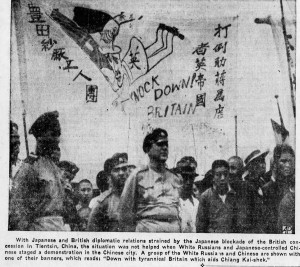Posted: July 17th, 2015 | No Comments »
Happened to be re-reading Andre Malraux’s The Conquerors at the moment which has a mention of Raffles Hotel in Singapore around 1925 (and published in 1928)….am intrigued by “shaddock flavoured lemonade”….

“…the Raffles Hotel, with its stiff, bare garden, its palms from the Botanical Gardens, its Sikh porter and its Chinese “boys”. Its lemonade with a shaddock flavour is the best in Asia…”
Shaddock, by the way, is I think better known these days as pomelo (citrus maxima), and looks rather like a big grapefruit. I am now seeking one out to squeeze into some lemonade.
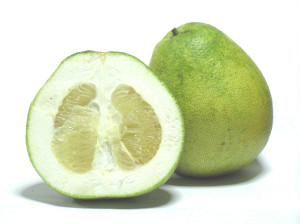
Posted: July 16th, 2015 | No Comments »
A few more Chinese parasols today (A common theme on this blog now and then as regular browsers will have observed, such as just this week on parasols in 1930s Bournemouth). As I’m on my holidays in France this week we’ll have the French photographer Jacques Henri Lartigue, who snapped the denizens of the French Riviera for years, starting in the early years of the century through to be about 1949. He was a man who loved his Chinese parasols – they feature repeatedly in his work. Here though some with really big, and very cool, parasols….
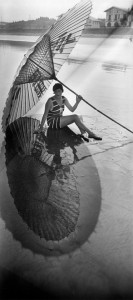
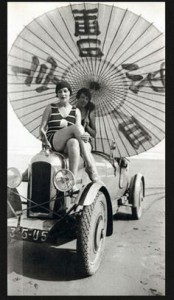
Posted: July 13th, 2015 | No Comments »
I love the site www.flashbak.com – always something interesting there. Recently they uploaded a bunch of photos of the Tollard Hotel in Bournemouth. Now Bournemouth is lovely, but the weather often leaves a little something to be desired compared to, say, the South of France or the Italian Riviera. The Tollard Hotel though came up with a rather good idea – a solarium and indoor beach. The hotel is now flats, so someone lives in the old solarium! All the photos of the amazing place, and the people who went there, are here
However, it’s been a while since we’ve had a Chinese parasol picture (though we’ve had loads before – at the Folies Bergere, Adele Astaire, Zelda Fitzgerald, Count Leopold von Sternberg, and some old French porn – so here’s some guests at the Tollard Solarium and indoor beach in 1930…
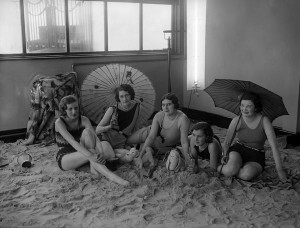

31st March 1930: A family relaxing together in the solarium of the Tolland Hotel, Bournemouth. (Photo by Fox Photos/Getty Images)
Posted: July 12th, 2015 | No Comments »
Last year I blogged about the first book in Robert Goddard’s The Wide World trilogy, The Ways of the World, which begins with events at the Paris Peace Conference in 1919 – Those that like a little alternative history should enjoy the series as it partly resolves around the machinations over the Shantung Question at Versailles (which I’ve written about myself in Betrayal in Paris, part of the Penguin China World War One series).

Anyway, in case you were wondering, the second in the series, The Corners of the Globe, continues the theme and plays out against the backdrop of the betrayal of the Chinese at Versailles and tells a credible alternative back story to the decisions over Shantung. The third, and final, book in the series, The Ends of the Earth, is just out and takes everyone to Japan to resolve issues. If you’re looking for some doorstop sized page turners for the summer holidays and fancy a bit of Buchan-like adventure then these might be your thing….

Posted: July 11th, 2015 | No Comments »
George Elliston (1883-1946) was a Kentucky born journalist who had a regular column syndicated across America that occasionally included a little of her own verse. Her poetry appeared in newspapers and magazines in the U.S. and was reproduced in anthologies in France, Germany, Great Britain and China. This poem – “Peking” – appeared in 1936….


George Elliston
Posted: July 10th, 2015 | No Comments »
Earlier this year I contributed a true story of a 1907 Shanghai murder to the UK Crime Writers’ Association anthology, Truly Criminal – it’s now available in the USA…So a quick re-cap….
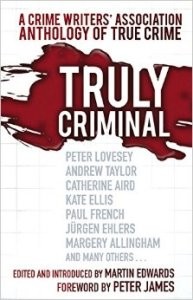
My contribution – A Murder in the Shanghai Trenches – is the true story of the 1907 murder of Eliza Shapera, a Jewish woman of dubious virtue, a prostitute, probably trafficked from Russia in the then notorious red light area of Scott Road in Hongkew, aka The Trenches. The murder was investigated by two veteran detectives of the Shanghai Municipal Police Detective-Sergeant Thomas Idwal Vaughn and Detective-Inspector John McDowell. Their investigation took them into the heart of The Trenches and the brothels of the area and their suspects included a mysterious Indian pimp, two Chinese house thieves and various Chinese and European prostitutes. It was a major cause celebre at the time and highlighted the dark underbelly of turn of the century Shanghai, a world of vice and crime that was to make the city notorious as it grew and festered throughout the first half of the twentieth century up to the Second World War. I’ve based my reinvestigation of the case on the newspaper articles and court documents of the time and, I think, that even after more than a century we can now see quite clearly who killed Eliza, and why they did it….
I’ve added some additional background on old Shanghai’s districts of sin and murder as well as an excerpt from the piece here on the Los Angeles Review of Books China blog and an interview on the case of Eliza Shapera and writing about old Shanghai on RTHK Radio 3 in Hong Kong…..
Posted: July 10th, 2015 | No Comments »
A while back I posted on the new edition of Ann Bridge’s classic novel of sojourning foreigners in interwar Peking, Peking Picnic. Due entirely to my own ignorance I erroneously suggested that Bridge had only written two novels dealing with China – Peking Picnic and The Ginger Griffin. Wrong! Thanks to a sharp eyed, and very well read, China Rhyming reader who pointed out that I had missed Bridge’s novel Four Part Setting. I’m afraid I don’t know the novel – though obviously will read asap – meanwhile here’s the Kirkus Review from October, 1939…
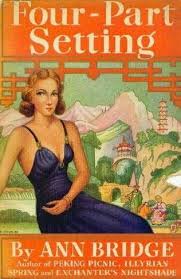
This book returns Ann Bridge to her earlier champ de combat, the Anglicized China of Peking Picnic and Ginger Griffin. It is in a sense a more mature book, a more astute one, limiting itself to the gently satirical dissection of five rather minor people. However, it lacks the plot sense of her earlier books — and this may be a stiff hurdle. The five are headed by Rose, a volatile, pretty, but integrally washy young woman, in flight from an un-understanding husband. Staying with her two cerebral cousins, she meets a happy amorist with whom she has an affair, and Hillier, a chronic cynic. The five take a long walking trip through North China, and their romantic inclinations jell, Rose turning from Henry to her cousin Antony, Hillier intrigued by the other cousin, Anastasia. And another reversal in Rose’s amatory progress by the close. Intelligent, perforating without acridity, but extremely conversational for so long a book, and Miss Bridge may be talking herself out of a very solid audience.
Posted: July 9th, 2015 | No Comments »
This picture from July 1939 is interesting – while Japanese anti-British demonstrations were a bit of a way of life in Shanghai and Tientsin after the war started in ’37, this picture shows the involvement in a demonstration of Chinese living within the Japanese concession (perhaps coerced, paid to attend?) and White Russian activists (probably in the pay of the Japanese or part of one of the various pro-fascist White Russian grouplets) – the slogan says “Knock Down Britain”. The primary gripe seems to be Britain’s support for Chiang Kai-shek and the Nationalists against the Japanese. Quite what uniform the White Russian is wearing is somewhat lost on me?
